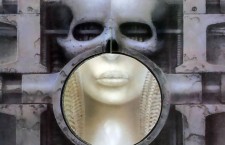There has been plenty of hand wringing, more recently, about the issue of fidelity in the Mp3 era. Less lamented, however, is the disappearance of album art. For artists like Greg Lake, whose initial rise to fame with King Crimson was sparked in part by one of the most iconic cover images in rock, that loss is no small thing.
“If I want to hear a track now, if I want to buy an album of an artist,” Lake tells Tony Peters in a newly posted talk, “I go to iTunes, I download it and I listen it. And it changes the whole dynamic. When people used to buy vinyl albums, there was something tactile about them. People almost used to feel that they’d come direct from the artist. Somebody once said, in a joke to me, and it was actually true: ‘Greg, I’ve got to tell you this, I used to smell them.’ [Laughs.] I used to smell them! And they did, because they contained the personal liner notes. They contained the artwork. The artist had a hand in the whole product.”
Lake is also associated with H.R. Giger’s memorable cover for 1973’s Brain Salad Surgery, by Emerson Lake and Palmer. Over his lengthy career, however, no Lake album image is perhaps more famous than Barry Godber’s harrowing creation for King Crimson’s 1969 debut In the Court of the Crimson King.
“When you bought that album,” Lake adds, “it was tactile. It had a feel. It was big enough to sit back and look at the album cover and actually get some benefit from the artwork. When you look into the screaming face of Schizoid Man [from King Crimson], you can’t help but be affected by it. It was one of the great things about this era of shared music. It wasn’t just the music; it was the artwork, as well.”
- Ernesto Cervini’s Turboprop, “When I Fall” (2024): Video premiere - March 15, 2024
- Disaster Pony,“Dead Neon & The Noon Sun” from ‘Disaster Pony’ (2024): Video premiere - February 27, 2024
- Christopher Hoffman, “Farewell Forever” from ‘Vision Is The Identity’ (2024): Streaming premiere - February 19, 2024




